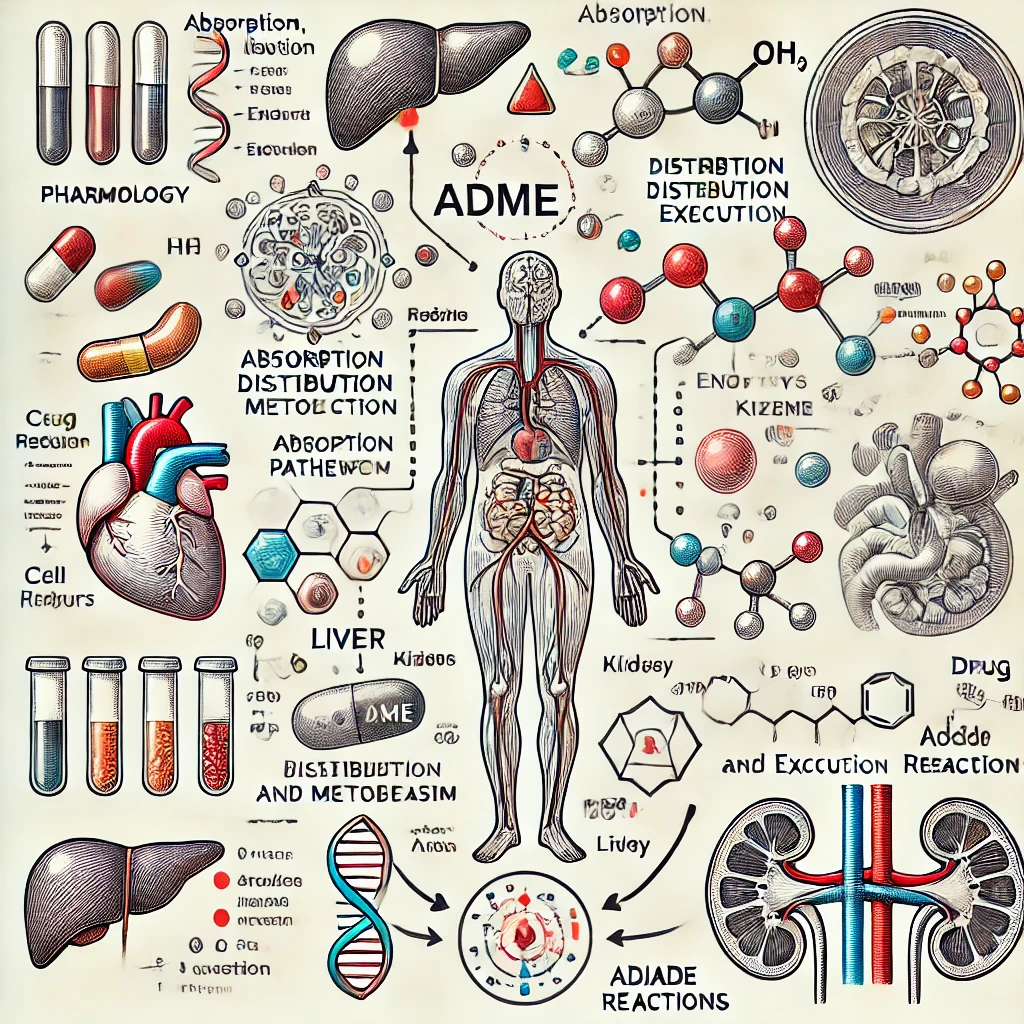Pharmacology is the scientific study of drugs and their interactions with living organisms. It is a vital field in medicine and healthcare, forming the basis for understanding how drugs can treat or prevent diseases, relieve symptoms, or affect the physiological and biochemical processes of the body. This article will delve into the fundamental concepts of pharmacology, focusing on drug actions, interactions, and the broader implications for medical treatments and patient safety.
What is Pharmacology?
Pharmacology is divided into two main branches: pharmacodynamics and pharmacokinetics. These terms, though technical, form the foundation for understanding how drugs work in the body.
- Pharmacodynamics deals with what the drug does to the body. This includes how drugs bind to receptors, initiate cellular responses, and achieve their therapeutic effects.
- Pharmacokinetics is concerned with what the body does to the drug. It involves the absorption, distribution, metabolism, and excretion of drugs, often abbreviated as ADME.
To understand how drugs work, one must explore both aspects: how the drug interacts with biological systems (pharmacodynamics) and how the body processes the drug (pharmacokinetics). Each plays a crucial role in determining the effectiveness and safety of medications.
Pharmacodynamics: The Science of Drug Action
At its core, pharmacodynamics is the study of how drugs interact with cellular receptors and enzymes to induce a therapeutic effect. A receptor is a protein molecule that resides on the surface or within a cell, to which a drug binds to either activate or inhibit a specific biological response. Agonists are drugs that bind to a receptor and activate it, while antagonists block or dampen a receptor’s activity without directly causing a response.
Mechanisms of Drug Action
Drugs can work through several mechanisms, including:
- Receptor interaction: Most drugs exert their effects by interacting with specific receptors in the body. For example, beta-blockers work by binding to beta-adrenergic receptors in the heart, slowing heart rate and reducing blood pressure.
- Enzyme inhibition: Some drugs work by inhibiting enzymes that catalyze specific biochemical reactions. For instance, statins lower cholesterol by inhibiting HMG-CoA reductase, an enzyme involved in cholesterol synthesis.
- Ion channels: Certain drugs modify the function of ion channels, proteins that regulate the movement of ions (e.g., calcium, sodium, potassium) across cell membranes. Calcium channel blockers, for example, reduce heart rate by limiting calcium influx into heart muscle cells.
- Transporters: Other drugs act on transporters, proteins that move substances like neurotransmitters across cell membranes. SSRIs (Selective Serotonin Reuptake Inhibitors), for instance, treat depression by blocking the reuptake of serotonin, thereby increasing its availability in the brain.
These mechanisms help explain how drugs produce therapeutic effects. For each class of drugs, the nature of the drug-receptor interaction and the downstream effects on biological processes determine how they are used in clinical settings.
Dose-Response Relationship
One of the core principles of pharmacodynamics is the dose-response relationship. This relationship defines how the magnitude of a drug’s effect is related to the dose administered. It is usually represented by a dose-response curve, a graph that shows the effect of increasing doses of a drug. The curve typically has three key points:
- Threshold dose: The minimum dose at which a drug begins to exert a therapeutic effect.
- Maximum effect (Emax): The point at which increasing the dose no longer enhances the drug’s effect.
- EC50: The dose at which 50% of the maximum effect is achieved. It is a measure of drug potency.
Understanding the dose-response relationship is essential for determining the optimal dose of a medication, balancing efficacy with the risk of adverse effects. Too low a dose may be ineffective, while too high a dose increases the risk of toxicity.
Pharmacokinetics: The Journey of Drugs Through the Body
While pharmacodynamics focuses on how drugs exert their effects, pharmacokinetics studies the movement of drugs through the body. This includes absorption, distribution, metabolism, and excretion (ADME). Each step is critical in determining the concentration of a drug at its site of action and, consequently, its therapeutic effectiveness.
Absorption
Absorption is the process by which a drug enters the bloodstream from its site of administration. The route of administration—whether oral, intravenous, subcutaneous, or inhaled—affects how quickly and efficiently a drug is absorbed. For example, drugs administered intravenously (IV) bypass the digestive system and are absorbed almost immediately into the bloodstream, providing rapid therapeutic effects. In contrast, oral medications must pass through the gastrointestinal tract, where factors such as food, pH, and intestinal motility can influence absorption.
The bioavailability of a drug is a key concept in pharmacokinetics and refers to the proportion of a drug that reaches the systemic circulation in an active form. Oral medications, for instance, often have lower bioavailability than IV drugs because they undergo first-pass metabolism in the liver, which can inactivate a portion of the drug before it reaches the bloodstream.
Distribution
Once absorbed, drugs are distributed throughout the body via the bloodstream. However, not all parts of the body receive the same concentration of a drug. The volume of distribution (Vd) is a theoretical value that indicates how extensively a drug is distributed in body tissues relative to the plasma. Drugs with a high Vd are distributed widely throughout the body, including in fat and muscle tissues, while drugs with a low Vd are primarily confined to the bloodstream.
Several factors influence drug distribution, including blood flow, protein binding, and the permeability of tissues. For example, the blood-brain barrier is a highly selective membrane that prevents many drugs from entering the brain, which can complicate treatment of neurological disorders.
Metabolism
Metabolism is the process by which the body chemically modifies drugs, usually to enhance their elimination. The liver is the primary site of drug metabolism, where enzymes such as those from the cytochrome P450 (CYP) family convert drugs into metabolites, which may be active or inactive. Some drugs, known as prodrugs, are inactive when administered and require metabolic conversion to become therapeutically active.
There are two phases of drug metabolism:
- Phase I reactions involve oxidation, reduction, or hydrolysis, often making drugs more water-soluble.
- Phase II reactions involve conjugation, where the drug is combined with another substance (e.g., glucuronic acid) to further enhance its solubility and facilitate excretion.
Metabolism can vary significantly between individuals due to genetic differences, age, liver function, and the presence of other drugs that may inhibit or induce metabolic enzymes.
Excretion
Excretion is the final step in the pharmacokinetic process, where drugs and their metabolites are eliminated from the body. The kidneys play a crucial role in excreting drugs through urine, although other routes of elimination include bile (feces), sweat, and exhalation.
The efficiency of drug excretion is often measured by its half-life, the time it takes for the concentration of a drug in the bloodstream to decrease by half. Drugs with short half-lives are eliminated quickly, requiring more frequent dosing to maintain therapeutic levels, while those with long half-lives may be dosed less frequently.
Drug Interactions
Drug interactions occur when the effects of one drug are altered by the presence of another drug, food, or environmental factor. These interactions can either enhance or reduce the therapeutic effect of a drug, sometimes leading to adverse outcomes.
Types of Drug Interactions
- Pharmacodynamic interactions: These occur when two drugs influence the same physiological system. For example, taking two drugs that lower blood pressure simultaneously may lead to excessive hypotension.
- Pharmacokinetic interactions: These involve changes in the absorption, distribution, metabolism, or excretion of a drug. For instance, one drug may inhibit the enzyme responsible for metabolizing another drug, increasing its concentration in the bloodstream and the risk of toxicity.
- Food-drug interactions: Certain foods can affect drug metabolism. Grapefruit juice, for example, inhibits CYP3A4 enzymes in the liver, potentially leading to dangerously high levels of some medications.
Individual Variability in Drug Response
Not all patients respond to drugs in the same way. Several factors contribute to individual variability in drug response:
- Genetics: Pharmacogenetics is the study of how genetic differences affect drug metabolism and response. For example, variations in the CYP2D6 enzyme can lead to faster or slower drug metabolism, affecting both efficacy and toxicity.
- Age: Both infants and the elderly may have altered pharmacokinetics, requiring careful dose adjustments. Neonates have immature liver and kidney function, while older adults may experience reduced drug clearance due to declining organ function.
- Gender: Hormonal differences between males and females can affect drug metabolism, distribution, and response.
- Disease state: Conditions such as liver disease, kidney failure, or cardiovascular disorders can significantly alter how drugs are processed in the body.
Adverse Drug Reactions and Toxicity
While drugs are designed to be beneficial, they can also cause harm, leading to adverse drug reactions (ADRs). ADRs can range from mild side effects, such as nausea or dizziness, to severe reactions, including allergic reactions, organ damage, or even death. Some common causes of ADRs include drug overdose, drug interactions, and individual variability in drug metabolism.
Conclusion
Pharmacology is a complex and dynamic field that underpins modern medicine. Understanding how drugs act
on the body, how the body processes them, and how they interact with other substances is crucial for the safe and effective use of medications. As science advances, the ability to tailor drug therapies to individual patients will continue to improve, enhancing both the efficacy and safety of treatments.
For healthcare providers and patients alike, a solid grasp of pharmacological principles is essential for making informed decisions about medications. By recognizing the factors that influence drug actions and interactions, we can better navigate the challenges of modern medicine and optimize patient outcomes.



